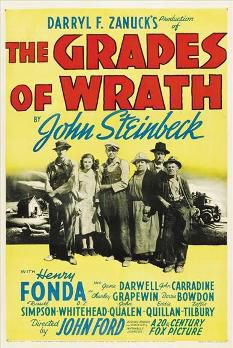The Grapes of Wrath

The Grapes of Wrath theatrical release poster
While John Ford was filming The Grapes of Wrath in 1940, St. Louis citizens were dumping the controversial "communist" novel into the Mississippi. Darryl F. Zanuck, head of Twentieth Century Fox, acquired the rights to John Steinbeck's novel, appointed the most respected screenwriter of the time, Nunnally Johnson, to write the script, and then negotiated for what seemed to be the obvious director, John Ford. Henry Fonda coveted the role of Tom Joad so much that he bargained away his career to get the role. But with the Hays Commission criticizing any overt political statement and the novel's controversy, Zanuck was worried about his prize property. Ford took his production inside a sound stage so that no one could interfere. Gregg Toland, whose stylized black-and-white photography would contribute greatly not only to Ford's The Long Voyage Home (1940) but also to Orson Welles's Citizen Kane (1941), was Ford's cinematographer. Toland's work became part of Ford's translation of Steinbeck's naturalism and pessimism to the screen.
In John Ford's films, one or two protagonists try to maintain their sometimes perverse individuality while helping some nuclear, professional, social, or makeshift family. Often the family or society may incorporate the individual into its mythology and thus guarantee cultural continuity. In John Steinbeck's novel, set in eastern Oklahoma during the Great Depression, family and individuality are crushed by the times. Ford's film doesn't cheat Steinbeck. It recognizes the times and Steinbeck's points (and even his tone), but it maintains Ford's romanticism (a romanticism that would dim with later films).
In the film, Ford and Toland's compositions confine or squeeze the protagonist, Tom Joad, played by Henry Fonda at his iconic best. Ford and Fonda, both cognizant of the dark side of the American male hero, present Tom Joad, a returning convict, in danger of turning sociopathic if not even psychopathic. When Ma Joad (Jane Darwell) first sees him upon his return from prison, she asks, "Did they [the prison, the system] hurt you and make you mean, mad?" From the way that Fonda conducts himself, from Ford's composition, we see that Tom could turn mean or mad. But his madness is the key to his salvation and his transcendence.
Casey, the preacher (John Carradine), becomes a stand-in for John the Baptist and anoints Tom Joad as the visionary. When Casey is killed, Tom, not yet fully aware of his new status, not fully past his psychopathic urges, kills a deputy. Later, fully aware of Casey's vision in his "I'll be there speech" to Ma, Tom becomes Emersonian: "Fella ain't got a soul, just a piece of the big soul. The big soul that belongs to everybody. I'll be all around in the dark." He walks into the dark and disappears, into the compositions that squeezed him. He may die, but he has learned something of a new consciousness, or maybe he has learned to forget his own consciousness in order to become a part of the flow of all life. His sacrifice makes society better. The only false note is the ending, Ma's "We're the People" speech that tries to turn the film into patriotic propaganda. Ford claims Zanuck attached the last scene; Johnson claimed that it was in his original script; Zanuck denied attaching it. In other words, no one claims it, for it smears this epic poem.
Ford's Grapes of Wrath is not so much a portrayal of a particular American time and place as a dark, brooding, but ultimately optimistic and poetic vision of America. It shows the way one medium can adopt or adapt from another to produce not a hybrid, not a completely different animal, but a meditation and variation on the tone and theme of the original.
See also IMAGES AND ICONS: Okies / PHYSICAL ENVIRONMENT: Dust Bowl / TRANSPORTATION: Route 66.
Jim Sanderson Lamar University
Gallagher, Tag. John Ford: The Man and His Films. Berkeley: University of California Press, 1986.
Place, J. A. The Non-Western Films of John Ford. Secaucus NJ: Citadel Press, 1979.
Sanderson, Jim. "American Romanticism in John Ford's The Grapes of Wrath: Horizontalness, Darkness, Christ, and F.D.R." Literature/Film Quarterly 17 (1989): 231–44.
Previous: Giant | Contents | Next: Gray, Coleen
XML: egp.fil.026.xml
